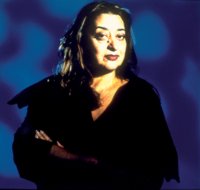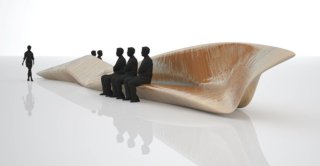Zaha Hadid
Padova - Palazzo della Ragione
Dal 26 ottobre all'1 marzo 2010
IV Edizione della Biennale Internazionale di Architettura Barbara Cappochin
Ospite d'onore della Biennale l'architetto Zaha Hadid, Premio Pritzker 2004 e protagonista mondiale del decostruttivismo: a Palazzo della Ragione, a Padova, la mostra monografica il cui progetto porta la sua firma.

Sarà una vera e propria grande installazione la mostra personale di Zaha Hadid, ospite d'onore della quarta edizione della Biennale internazionale di Architettura "Barbara Cappochin", dal prossimo ottobre a Palazzo della Ragione a Padova.
L'esposizione farà conoscere i numerosi e innovativi progetti di uno gli interpreti più significativi nella scena mondiale del decostruttivismo in architettura. Irachena di nascita e naturalizzata a Londra alla fine degli anni '70, la Hadid è stata la prima donna a vincere nel 2004 il Premio Pritzker, che equivale al Premio Nobel per l'architettura. Moltissimi i progetti realizzati in tutto il mondo, tra gli ultimi in corso quello rivoluzionario per il MAXXI di Roma, il Museo Nazionale delle Arti del XXI secolo che sarà ultimato proprio alla fine di quest'anno.

Dopo Mario Botta (2003), David Chipperfield (2005) e Kengo Kuma (2007), ZAHA HADID allestirà la sua mostra personale per la Biennale, in uno dei monumenti più famosi di Padova, nonché degli edifici simbolo della città. Oltre all'importante valenza storica, il "Salone"di Palazzo della Ragione, infatti, riveste una notevole importanza anche da un punto di vista artistico e architettonico: è infatti decorato con uno stupendo ed elaborato ciclo di affreschi e si ritiene che il suo tetto sia il più largo in Europa costruito senza il supporto di colonne.
Il Palazzo stesso, dunque, è per Zaha Hadid un'importante occasione per realizzare un progetto di design "a forte impatto". Accettando la sfida di intervenire nel rispetto delle caratteristiche contestuali e architettoniche, la Hadid "vede" il Salone come un campo sul quale le coordinate esistenti dello spazio (le aperture delle porte) agiscono come forze in movimento. Questo "campo di forze" è tradotto dall'architetto con la creazione di un mondo di forme ondulate: un paesaggio fatto di blocchi, basamenti e segni sul pavimento; "guidati" proprio dalle geometrie dei blocchi sarà possibile per i visitatori apprezzare gli affreschi e le sculture presenti al Salone. I blocchi definiti dalle regole della continuità e della rottura generano isole distinte tra loro, ognuna di queste isole (lines\bundles\networks - waves\shells\cocoons - aggregations\clusters\jigsaws - fields - landscape&topography - parametricism), definisce le morfologie concettuali che sottendono l'intera esposizione. I basamenti diventano non solo parte integrante dell'opera dell'architetto, ma all'occorrenza posti a sedere per i visitatori. Anche i segni sul pavimento divengono elementi costitutivi dell'intero allestimento, agendo come segnali visivi che indicano la direzione nella visita alla mostra che si sviluppa sui complessivi 2.500 metri quadri di area del Salone.
Zaha Hadid sperimenta nuovi concetti di spazio che intensificano il panorama urbano esistente nella ricerca di un'estetica visionaria comprendente tutti i campi del design, passando dalla dimensione urbana ai prodotti, dagli interni all'arredamento. Fondamentale per lei è il rapporto tra architettura e paesaggio che, combinandosi assieme, portano a risultati inaspettati in termini di dinamismo delle forme.
Porta sempre la firma di Zaha Hadid il progetto del "Tavolo dell'architettura" che esporrà le serigrafie di tutti i progetti partecipanti alla quarta edizione del Premio Internazionale di Architettura "Barbara Cappochin", i cui vincitori saranno proclamati il prossimo 26 ottobre (data di inaugurazione della mostra relativa).
La Biennale, giunta alla quarta edizione, si propone di promuovere la qualità dell'architettura come obiettivo che, oggi più che mai, tocca non solo le dimensioni del costruire e dell'abitare, ma anche lo stesso vivere nelle città.
L'iniziativa è promossa dalla Fondazione "Barbara Cappochin" e dall'Ordine degli Architetti, Pianificatori, Paesaggisti e Conservatori della provincia di Padova insieme alla Regione del Veneto e al Comune di Padova, in collaborazione con l'Unione Internazionale degli Architetti (U.I.A) e il Consiglio Nazionale Architetti Pianificatori Paesaggisti e Conservatori (C.N.A.P.P.C.).
October 2009 - A major retrospective on the works of Zaha Hadid Architects will take place within the salone of Palazzo della Ragione, Padua, Italy in October. The exhibition will examine the practice's continued experimentation and research into digital design and construction methods at the cutting edge of the industry.
The salone of Palazzo della Ragione (constructed 1172-1219) is considered one of the most notable monuments in Padua. Its medieval roof remains amongst the largest in Europe unsupported by columns, whilst the frescoes that adorn the interior walls date from 1425. As with each of her projects, Hadid has organized this exhibition as a direct response to its environment within the salone, articulating the inherent contextual relationships of her work.
The historic qualities of the space presented an exacting design challenge for Hadid. The exhibition design respects these spatial and contextual characteristics whilst also intervening in the unique manner of Hadid's digital, liquid fluidity. Conceived as an interior urban landscape, the exhibition should be considered as a large scale installation; a pixilated field defined by algorithmic formulae that introduce complexity and generate an interior urban condition. Space has been organized as a single fluid landscape with connecting individual fragments and clusters.
The works in the exhibition are classified not by the usual categories of typology or chronology, but by the design theme and agenda that generated them. In this way, the widest variety of Hadid's projects, whether a piece of furniture or a vast infrastructure project, are arranged within the same zone, irrespective of their function or scale. These groupings include:
1. Lines/Bundles/Networks
2. Waves/Shells/Cocoons
3. Aggregations/Clusters/Jigsaws
4. Fields
5. Landscape & Topography
6. Zaha Hadid Architects. A sixth island cluster is dedicated to Zaha Hadid Architects as a practice, its organization and its research. Addressing the demand for an increased level of articulated complexity, the practice has evolved its experimentation by means of retooling its research methods on the basis of parametric design systems. Works exhibited here demonstrate the practice's continued development of this architectural paradigm.
Product designs include some of Hadid's most notable pieces and examine the diversity of her work including Mesa Table for Vitra, Genesy Lamp for Artemide, Aqua Table for Established & Sons, Melissa Shoes, sofas for Sawaya & Moroni and B&B Italia, and Louis Vuitton's Icone bag. Many of these pieces are now exhibited at museums and galleries worldwide and have become collectors' pieces alongside design classics from previous centuries.
WORKS INCLUDED WITHIN EACH ‘CLUSTER' OF THE EXHIBITION:
LINES/ BUNDLES/ NETWORKS
Architectural Projects
Maxxi, National Of Xxist Century Art, Rome, Italy
BMW Central Building, Leipzig, Germany
Citylife Tower & Masterplan, Milano, Italy
Glasgow Riverside Museum, Glasgow, Scotland
Cma Cgm Tower, Marseille, France
Zaragoza Bridge Pavilion, Zaragoza, Spain
Signature Towers, Dubai, Uae
Products
Mesa Table For Vitra
Genesy Lamp For Artemide
WAVES/ SHELLS/ COCOONS
Architectural Projects
Salerno Maritime Terminal, Salerno, Italy
Guangzhou Opera House, Guangzhou, China
Nordpark Railway Stations, Innsbruck, Austria
London Aquatics Centre, London, UK
University Of Seville Library, Seville, Spain
Museum Of Nuragic & Contemporary Art, Cagliari, Italy
Mobile Art Chanel Contemporary Art Container
Regium Waterfront, Reggio Calabria, Italy
World Design Plaza & Park, Seoul, Korea
Vilnius Museum, Vilnuis,
Cairo Expo City, Cairo, Egypt
Products
Aqua Table For Established & Sons
Z_Car I & Ii For Kenny Schachter At Rove
Zaha Hadid Shoes For Melissa
Belu Bench For Kenny Schachter At Rove
Scoop Sofa For Sawaya & Moroni
Flow For Serralunga
FIELDS
Architectural Projects
Hoenheim-Nord Terminus, Strasbourg, France
One-North Masterplan, Singapore
Nyc 2012 Olympic Village, New York, Usa
Kartal Pendik Masterplan, Istanbul, Turkey
E.On Energy Research Department-Rwth Aachen, Germany
Bahrain International Circuit, Bahrian
Zorrozaurre Masterplan, Bilbao, Spain
Farrer Court, Singapore
New Passenger Terminal And Masterplan, Zagreb Airport
Stone Towers, Cairo
Products
Icone Series Bag For Louis Vuitton
Dune Formations For David Gill Galleries
AGGREGATIONS/ CLUSTERS/ JIG-SAWS
Architectural Projects
The Peak, Hong Kong
Zollhof 3 Media Park, Dusseldorf, Germany
Spittelau Viaducts Housing, Vienna, Austria
Lois And Richard Rosenthal Center Of Contemporary Art, Cincinnati, Usa
Pierres Vives, Montpellier, France
Spiralling Tower, Barcelona, Spain
Eli & Edythe Broad Art Museum, East Lansing, Usa
Citadel Capital Office Buildings, Cairo, Egypt
Galaxy Soho, Beijing, China
Products
Tea And Coffee Set, Sawaya & Moroni
Crevasse Vases For Alessi
Wmf Cutlery
Silver Bowl For Sawaya & Moroni
Moon Sofa For B&B Italia
Crater For David Gill Galleries
Z-Play
LANDSCAPE & TOPOGRAPHY
Architectural Projects
Vitra Fire Station, Weil Am Rhien, Germany
Landscape Formation One (Lf One), Weil Am Rhien, Germany
Zaha Hadid Door Handles For Valli & Valli
Bergisel Ski Jump, Inssbruck, Austria
Phaeno Science Center, Wolfsburg, Germany
Hotel Puerta America, Madrid, Spain
High-Speed Train Station, Napoli Afragola, Italy
Eusko Tren Headquarters And Urban Planning, Durango, Spain
Jesolo Centre, Jesolo, Italy
Opus Office Tower, Dubai, Uae
Innovation Tower Hong Kong Polytechnic University, Hong Kong
Sofia Karo Multifunctional Masterplan, Sofia, Bulgaria
Products
Z-Scape For Sawaya & Moroni
Niche For Alessi
PARAMETRICISM RESEARCH
Abu Dhabi Performing Arts Centre, Abu Dhabi, Uae
Global Cities Exhibition, Tate Modern
Reinventing Towers
Zaha Hadid Footwear For Lacoste
LAUNCH OF TAVOLO DELL'ARCHITETTURA, PADUA
To coincide with the exhibition, Zaha Hadid Architects have designed a 20 metre long wooden table with seating for Cavour Square in Padua.
In continuing the research on innovative materials and challenging building techniques a traditional construction material has been completely reinvented. The object is designed to challenge the usual perception of wood as a sheet or stick material, rediscovering the sculptural potential of the wooden mass. A large block of wood is carved out by dynamic forces to create an undulating structure, installed as a large scale piece of urban furniture which will attract and surprise the pedestrian flow around it. Seating areas as well as displays are provided within the sculpture.
The top undulating surface is panelised to generate a series of elements that can display architectural projects, as it will be used to showcase the winners of the 2009 Barbara Cappochin Biennale. The digital three-dimensional file of the design by Zaha Hadid Architects has been engineered and created by the main contractor, Ar.Te, which printed the table, sculpting out the large wooden structure. The piece is subdivided into modules, allowing it to be transported to several locations worldwide after the 2009 Biennale.
Data:
Tavolo dell'Architettura, Padua 2009
Material: Poplar Wood, 20x2x2 meters, 7.5 tonnes
Client: Barbara Cappochin Foundation
Design: Zaha Hadid Architects
Main Contractor: Ar.Te
Notes for editors:
ZAHA HADID RETROSPECTIVE EXHIBITION
Palazzo della Ragione, Padua, Italy
Barbara Cappochin Biennale, 4th Edition
27 Oct 2009 - 01 March 2010
ABOUT ZAHA HADID
Zaha Hadid was awarded the Pritzker Prize in 2004 and is widely regarded as an innovative architect who constantly tests the boundaries of architecture, urbanism and design. An aspect of Hadid's vision is her interest in the rigorous interface between architecture, landscape, and geology.
Currently Zaha Hadid architects are working on a multitude of projects around the world including the MAXXI: National Museum of XXI Century Arts, Rome, that will be completed later this year. Zaha Hadid's work of the past 30 years was the subject of a critically-acclaimed retrospective exhibition at New York's Solomon R. Guggenheim Museum in 2006 and was showcased in 2007 at the Design Museum in London.